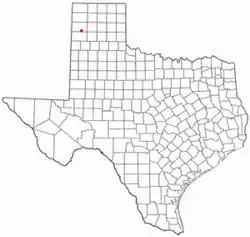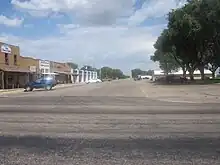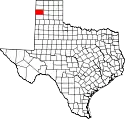Vega, Texas | |
|---|---|
.jpg.webp) Downtown Vega | |
 Location of Vega, Texas | |
 | |
| Coordinates: 35°14′44″N 102°25′30″W / 35.24556°N 102.42500°W | |
| Country | United States |
| State | Texas |
| County | Oldham |
| Area | |
| • Total | 1.34 sq mi (3.47 km2) |
| • Land | 1.34 sq mi (3.47 km2) |
| • Water | 0.00 sq mi (0.00 km2) |
| Elevation | 4,029 ft (1,228 m) |
| Population (2010) | |
| • Total | 884 |
| • Estimate (2019)[3] | 924 |
| • Density | 690.58/sq mi (266.56/km2) |
| Time zone | UTC-6 (Central (CST)) |
| • Summer (DST) | UTC-5 (CDT) |
| ZIP code | 79092 |
| Area code | 806 |
| FIPS code | 48-75188 [4] |
| GNIS feature ID | 2412147[2] |
| Website | oldhamcofc.org |



Vega is a city and county seat of Oldham County, Texas, United States. The population was 884 at the 2010 census, down from 936 at the 2000 census.
History
In 1879, the area was opened by the state for homesteading. The first settler, N.J. Whitfield, arrived in 1899. On October 17, 1899, he purchased part of Oldham County known as Section 90 at a per-acre rate of US$1 (equivalent to $35.18 in 2022).[5] In 1903, Whitfield sold a 100-foot (30 m) strip of land that extended across the southern part of Oldham County to the Choctaw, Oklahoma, and Texas (later Rock Island) Railroad as a right-of-way.[6] He then sold portions of land on the south side of the right-of-way to other settlers. A. M. Miller and Howard Trigg surveyed the town site that eventually became Vega in May 1903.[7] The name Vega, which is Spanish for "meadow", was chosen because it reflected the vast prairie and surrounding countryside of the area.[6][8] Soon after, Miller opened a store, and a post office, saloon, and a school that doubled as a Masonic Lodge were built in the community. In 1907, ranchers Patrick and John Landergin purchased a part of the LS Ranch from Swift & Company. Working in association with the Amarillo, Texas-based Pool Land Company, the Landergin brothers brought more prospective settlers to the community.[7]
The nearby town of Tascosa, which was designated Oldham County seat in 1880, declined in both importance and population as Vega grew. A five-year battle over which community should serve as Oldham County's seat of government was put to a vote in 1915.[9] In the special election, citizens chose to move the county seat from Tascosa to Vega. Until a permanent courthouse was built, county business was conducted in Vega's Oldham Hotel.[6][7][10]
Modern amenities, such as telephone service, were introduced during the 1920s. In 1926, Route 66 (superseded by Interstate 40) was commissioned as a link from Chicago to Los Angeles and ran through Vega along the Old Ozark Trail.[5]
Vega was officially incorporated in 1927, and the population was 519 in the 1930 census. On May 3, 1931, a fire destroyed six buildings west of the courthouse square. Two months later, a second fire burned two buildings on the north side of the square. These fires prompted the town to establish a municipal water system.[7]
Geography
Vega is located at 35°14′44″N 102°25′30″W / 35.24556°N 102.42500°W (35.245547, –102.425112).[11] It is situated at the junction of Interstate 40 (Old Route 66) and U.S. Highway 385 in southern Oldham County, approximately 30 miles west of Amarillo.[10]
According to the United States Census Bureau, the city has a total area of 1.1 square miles (2.8 km2), all land.
Climate
According to the Köppen Climate Classification system, Vega has a semi-arid climate, abbreviated "BSk" on climate maps.[12]
Demographics
| Census | Pop. | Note | %± |
|---|---|---|---|
| 1930 | 519 | — | |
| 1940 | 515 | −0.8% | |
| 1950 | 620 | 20.4% | |
| 1960 | 658 | 6.1% | |
| 1970 | 839 | 27.5% | |
| 1980 | 900 | 7.3% | |
| 1990 | 840 | −6.7% | |
| 2000 | 936 | 11.4% | |
| 2010 | 884 | −5.6% | |
| 2019 (est.) | 924 | [3] | 4.5% |
| U.S. Decennial Census[13] | |||
2020 census
| Race | Number | Percentage |
|---|---|---|
| White (NH) | 639 | 72.7% |
| Native American or Alaska Native (NH) | 4 | 0.46% |
| Asian (NH) | 7 | 0.8% |
| Mixed/Multi-Racial (NH) | 32 | 3.64% |
| Hispanic or Latino | 197 | 22.41% |
| Total | 879 |
As of the 2020 United States census, there were 879 people, 366 households, and 267 families residing in the city.
2000 census
As of the census[4] of 2000, there were 936 people, 378 households, and 275 families residing in the city. The population density was 866.7 inhabitants per square mile (334.6/km2). There were 407 housing units at an average density of 376.9 per square mile (145.5/km2). The racial makeup of the city was 94.76% White, 0.96% African American, 0.75% Native American, 0.21% Asian, 2.88% from other races, and 0.43% from two or more races. Hispanic or Latino of any race were 9.40% of the population.
There were 378 households, out of which 31.2% had children under the age of 18 living with them, 58.7% were married couples living together, 12.7% had a female householder with no husband present, and 27.0% were non-families. 24.6% of all households were made up of individuals, and 13.5% had someone living alone who was 65 years of age or older. The average household size was 2.46 and the average family size was 2.93.
In the city, the population was spread out, with 26.9% under the age of 18, 7.6% from 18 to 24, 24.6% from 25 to 44, 24.1% from 45 to 64, and 16.8% who were 65 years of age or older. The median age was 39 years. For every 100 females, there were 87.6 males. For every 100 females age 18 and over, there were 83.9 males.
The median income for a household in the city was $30,481, and the median income for a family was $35,227. Males had a median income of $27,120 versus $22,500 for females. The per capita income for the city was $17,315. About 12.3% of families and 14.8% of the population were below the poverty line, including 20.0% of those under age 18 and 9.1% of those age 65 or over.
Education
Public education in the city of Vega is provided by the Vega Independent School District. In recent years, the district has had a total enrollment of between 250 and 300 students.
All Vega ISD students are housed on a single campus located at 200 Longhorn Drive. The campus is split into two schools – Vega Elementary School (grades K–6) and Vega High School (grades 7–12). In addition, students in grades 7–12 from the neighboring Wildorado Independent School District in Wildorado attend Vega High School unless their parents choose another of Wildorado's neighboring districts.[17]
Public library
The library was originally built in 1911 and housed a silent movie theater; today, it touts 11,000 volumes.[18]
References
- ↑ "2019 U.S. Gazetteer Files". United States Census Bureau. Retrieved August 7, 2020.
- 1 2 U.S. Geological Survey Geographic Names Information System: Vega, Texas
- 1 2 "Population and Housing Unit Estimates". United States Census Bureau. May 24, 2020. Retrieved May 27, 2020.
- 1 2 "U.S. Census website". United States Census Bureau. Retrieved January 31, 2008.
- 1 2 "Vega, TX". Oldham County Chamber of Commerce. Retrieved July 17, 2009.
- 1 2 3 "Vega, Texas - Prairie Town in the Panhandle". Legends of America, A Travel Site for the Nostalgic & Historic Minded. Retrieved July 17, 2009.
- 1 2 3 4 "Vega, Texas". The Handbook of Texas online. Retrieved July 17, 2009.
- ↑ "Vega, Texas is a Route 66 Town!". The Road Wanderer. Retrieved July 17, 2009.
- ↑ "Oldham County, Texas". The Handbook of Texas online. Retrieved July 17, 2009.
- 1 2 "Historic Vega, Texas on old Route 66". Texas Escapes Online Magazine. Retrieved July 17, 2009.
- ↑ "US Gazetteer files: 2010, 2000, and 1990". United States Census Bureau. February 12, 2011. Retrieved April 23, 2011.
- ↑ Climate Summary for Vega, Texas
- ↑ "Census of Population and Housing". Census.gov. Retrieved June 4, 2015.
- ↑ "Explore Census Data". data.census.gov. Retrieved May 19, 2022.
- ↑ https://www.census.gov/
- ↑ "About the Hispanic Population and its Origin". www.census.gov. Retrieved May 18, 2022.
- ↑ "District Information". Vega Independent School District. Archived from the original on July 17, 2011. Retrieved July 17, 2009.
- ↑ "Harrington Library Consortium - Oldham County Library". Archived from the original on May 9, 2008. Retrieved May 20, 2008.
External links
 Vega (Texas) travel guide from Wikivoyage
Vega (Texas) travel guide from Wikivoyage Media related to Vega, Texas at Wikimedia Commons
Media related to Vega, Texas at Wikimedia Commons- Oldham County Chamber of Commerce
- Vega Independent School District
